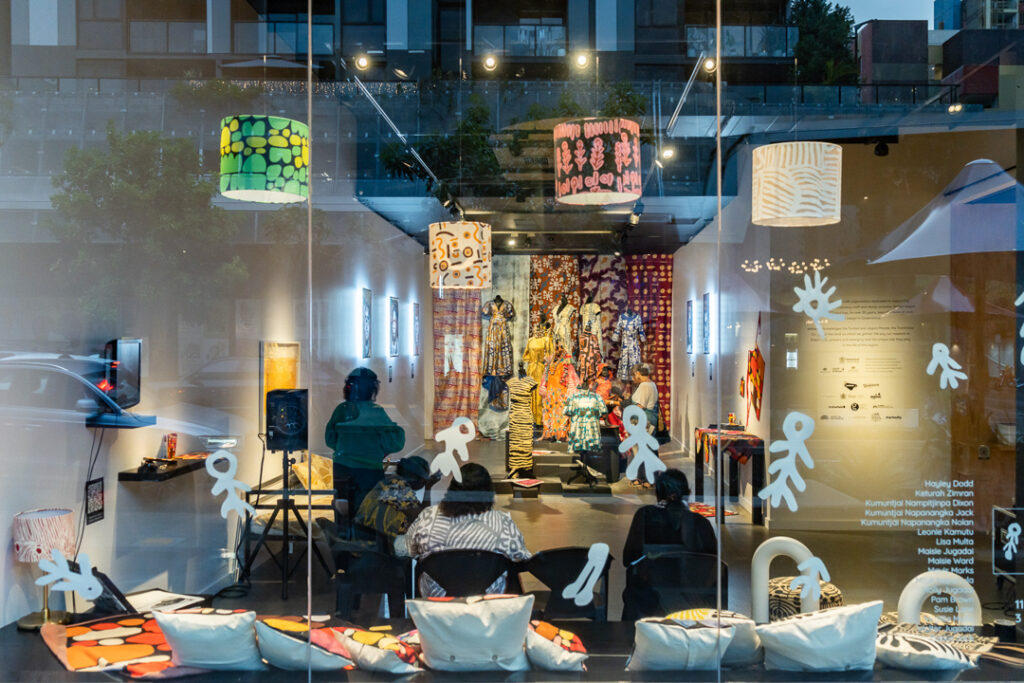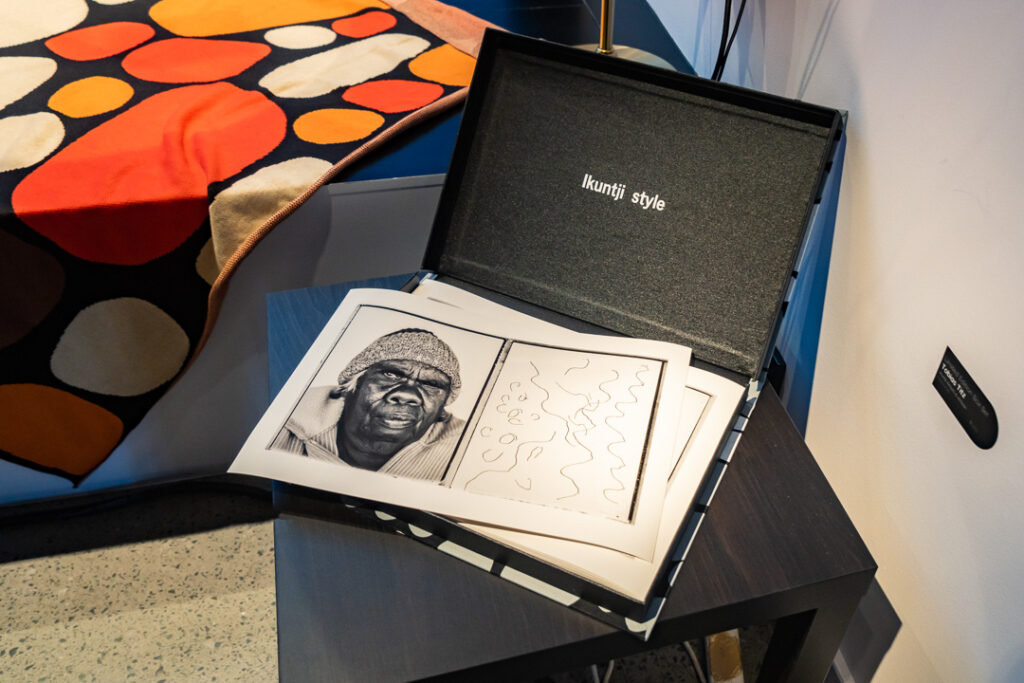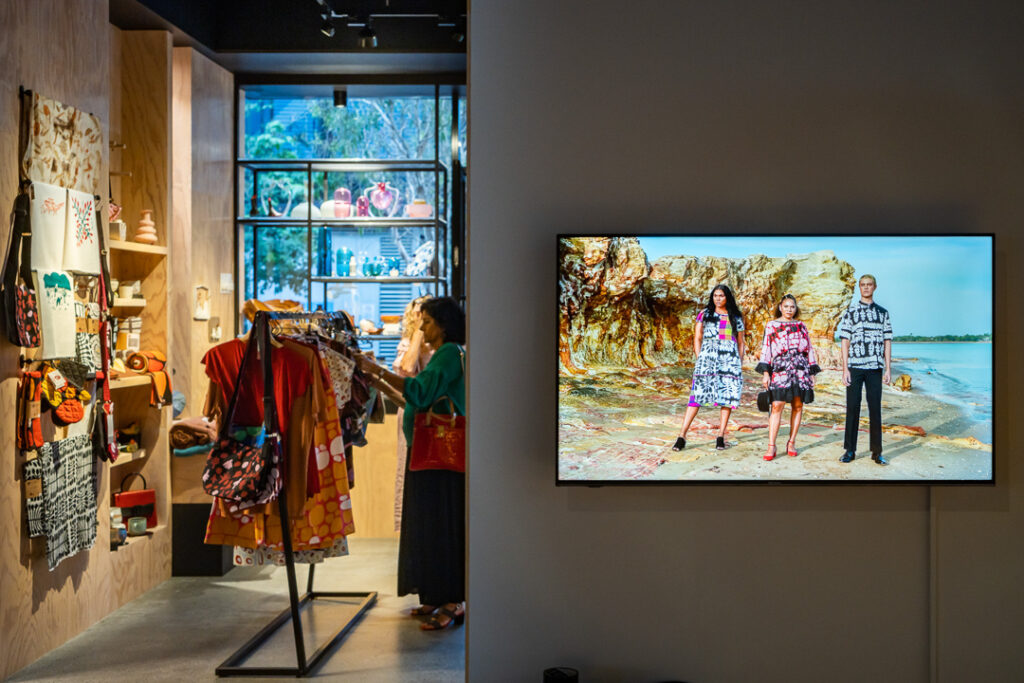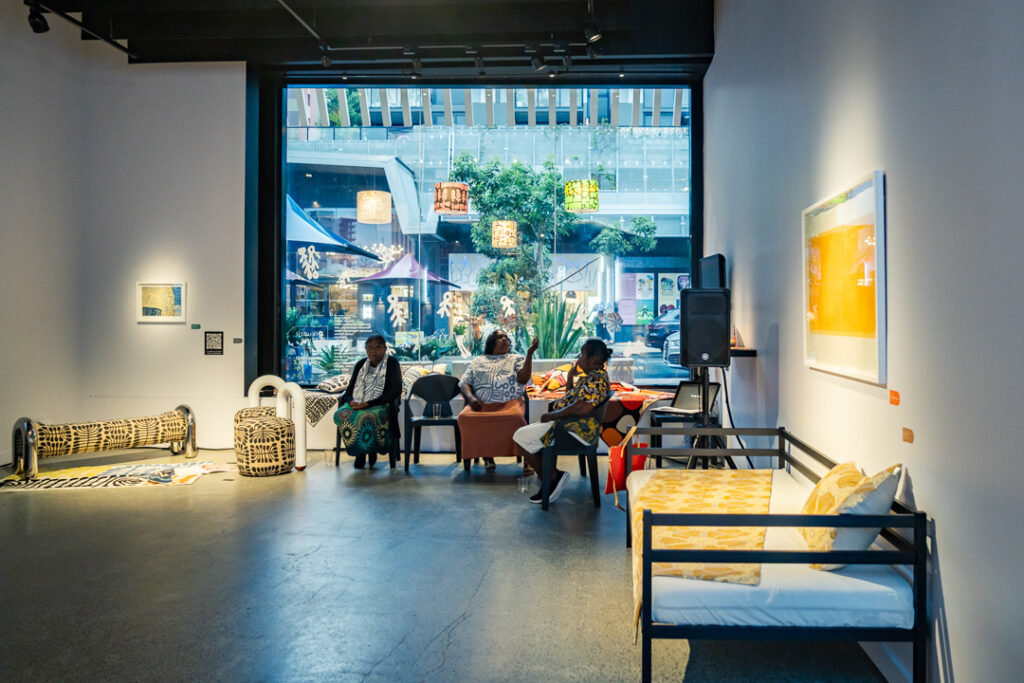Bowie Dunne speaks with Western Desert textile artist Keturah Zimran about her designs inspired by Country.
We would like to pay our respects to both the Turrbul and Jagera Peoples, who are the Traditional Custodians of the land on which we work, live and create. We recognise their role in caring for and maintaining Country over many millennia. May we remember and acknowledge this history of important cultural knowledge. May we recognise the rich cultural heritage of this country and appreciate the traditions of oral histories, beliefs and values. Let us remember and appreciate the thousands of years of spoken history that precede us and continue to live. To elders past and present, we pay our respects.
Accompanying the design-led exhibition Ikuntji Style, a small group of passionate individuals, artists and curators celebrated the legacy of Ikuntji Artists. The artists and audience shared in storytelling to explore the history of Ikuntji Artists. It was a privilege to witness this afternoon of conversation when the artists shared stories of their Tjukurrpa (Dreaming). The conversation highlighted the importance of respect in regard to public and private knowledges: the artists shared their Tjukurrpa (Dreaming) and stories of Ikuntji Artists’ rich history.
Founded in 1992, Ikuntji Artists was the first arts centre established by First Nations women in the Western Desert Art Movement. Ikuntji Artists have given opportunities to generations of artists to continue crucial cultural learning and explore a design-led journey simultaneously. There has been a clear evolution of personal empowerment for the First Nations women of Ikuntji/Haasts Bluff as Ikuntji Artists continues to grow. Artists Keturah Zimran, Kelly Dixon and Pam Brown led the audience through their personal histories. They explored connections to Country, generously shared small windows into the process of their practices and discussed the impact of Ikuntji Artists on a global stage. Throughout the intimate conversation, it was clear that years of hard work and dedication had accrued in their impressive resumés.
Global recognition of their work is indicative of showcasing their designs in artisanal dresses at the London Pacific Paris Fashion Week 2022. The artists expressed an overwhelming sense of pride that their work had been recognised globally.
Ikuntji Style, curated by artisan’s Cassandra Lehman and Ikuntji Artists’s Dr Chrischona Schmidtt, showcases the entirety of Ikuntji Artists’ array of textiles and applications. Ikuntji Artists works with ethical and fair trade companies worldwide, establishing a positive and sustainable effort towards changing the pace of global consumerism. Companies such as Publisher Textiles, Flying Fox Fabrics, Better World Arts and various high-end Australian designers and makers become a vital part of the process at Ikuntji Artists. The exhibition showcases over twenty artists’ work. Each segment of the exhibition displays a vast array of Ikuntji Artists’ items, ranging from ball gowns to metres of silks to pillowcases, and one-of-a-kind paintings. The diverse range of work demonstrates not only a design-led journey, but also an homage to installation art. Lehman’s curation of the space focuses the attention on the items, not only to represent intended practical use, but also to create a subversion of the gallery space. Blurring lines between fine art and the home is not a new concept by any means in contemporary art, but instead makes an effort to re-introduce accessibility to fine art spaces and institutions. Artisan’s gallery space was transformed into a picturesque image of the homely, blended with the elegant structural installation of hand-made gowns of linen and silk with the designs of Ikuntji Artists’ makers.
Generations of stories and story-telling are made visible by each piece. Ikuntji Artists have preceded generations of artists to continue the vital opportunity for First Nations women of Ikuntji to explore their autonomy within art and business. In the history of white Australia, autonomy has often been stripped from Indigenous communities such as the Ikuntji Art Centre. Keturah and Alice shared the sentiment “little money but my own money”, which was a key phrase in the conception of Ikuntji Artists. Ikuntji Art Centre Manager, Dr Chrischona Schmidtt, explained that her introduction to Ikuntji Artists was based on her doctoral research of the history of the Utopia art movement and the art market (James Cook University, 2022). The utopia art movement facilitated the “emergence of Aboriginal women artists across the Western Desert” and aided in a new development for Indigenous women in the art space. After completing her doctorate, Chrischona expressed her interest in working with women in art centres, “I wanted to work with women again”. Dr Schmidtt spoke of her involvement in Ikuntji Artists and detailed how their journey has influenced her development, both professionally and personally. The artists and Dr Schmiddt highlighted that the designs of each artist are licensed and therefore, the money from sales is deposited mostly in the artist’s pockets. Monetary autonomy allows the women of Ikuntji artists to distribute the wealth for themselves and the wider community, quoting the cyclical nature of material possessions and money within their tight-knit community.
Dr Schmidtt explained the purpose of working with sustainable and slow-fashion production brands to construct the textiles sampled by the Ikuntji Design exhibition. There is a constant communication process between each artist and Dr Schmidtt, seeking to ensure that the designs uphold cultural integrity. Dr Schmiddt explained that her role is to reach an understanding about the use of the designs after the fabrics are sold, ensuring that the important nuances of the work are able to be utilised on chairs, dresses or items that would not disrespect the original artwork and its story. There was a unanimous understanding in the room during this part of the Artist’s talk about the importance of respecting the artist’s unique Tjukurrpa. Conversations about ethics in regard to production, conception and selling filled the audience with a deeper understanding of the entire process behind the scenes at Ikuntji Artists. The sustainable sourcing of the fabrics and items themselves, such as Better World Arts allows for high-quality pieces and limited environmental impact, making the items extremely sought after.
Each of the pieces throughout the exhibition space combines practicality and artistic vision, cementing the appreciation of the domestic and breaching the gap between gallery and home. The incredible hand-made gowns and floor-to-ceiling silks displayed at the heart of the exhibition highlight this meld of high art and accessibility. Each gown is designed by Australian designers and is a staple of fashion and design.
- Dress 1: Textile design: Tali Tali Sandhills by Alice Nampitjinpa Dixon. Fabric: Ochre and Yellow on Black Tuscany Linen. Dress Creation by Carolyn Smith, Frock On, 2021 . Dress 2: Textile design: Puli Puli Rocks by Keturah Zimran. Fabric: Black and Silver on Peacock Silk. Dress Worn by Jessica Mouboy, Indigenous Fashion Projects Runway, 2021 Dress 3: Textile design Tjilkamala Rockholes by Alice Nampitjinpa Dixon. Fabric: Red and orange on gray cotton. Children’s Skirt, Hat & Top – Otoshiana Pockets, Outfit by Cara Bailie (image by Louis Lim)
- Limited Edition Box Set, Photography: Tobias Titz, Portrait of Leonie Kamutu, with etching: Papa Tjukurrpa story, by Leonie Kamutu. Fabric: Puli Puli Rockholes by Keturah Zimran (image by Louis Lim)
- Artisan Store and Installation view - Ikuntji Style. Frock On 2022 video (image by Louis Lim)
- Kelly Dixon, Keturah Zimran and Pam Brown, seated next to Arch Mellows and Arch Bench, , Furniture designed by: CJ Anderson, Fabric: Mitjili Napurrula, Watiya Tjuta fabric: linen, (Image courtesy of artisan).
The design behind Keturah Zimran’s Puli Puli Rocks Tjukurrpa is reminiscent of a post-minimalist style, featuring smooth organic shapes as a key design feature. The monochromatic variants throughout the adaptations of the design for each fabric iteration work cohesively to explore a colour story, in conversation with shape and form. Zimran’s use of form is interesting, as the organic differences between rocks and sandhills create movement and virality in the design. The eye of the viewer is enraptured by the dips and curves of the sandhills and rock pools which creates a dynamic and unique design. As a student of the arts myself, I found myself reminded of the artistic conventions of the post-minimalist era. With no formal study of this era, Zimran interprets visual similarities of the era in a completely unique and resolved artwork. I was enamoured by this connection of what seemed like pure coincidence and artistic vision on Zimran’s part. Much like many artists of the post-minimalist era, Zimran evokes an abstract version of the organic shapes found in nature, adding her own significance to her country and culture. Much like Zimran’s Tjukurrpa, the bright colours and organic shapes call upon memories of home and belonging.
I had the opportunity to speak with Keturah Zimran, key artist and board member of Ikuntji Artists, to explore her experience with Ikuntji Artists’ global reach. Keturah found that through meeting Dr Chrischona Schmidtt, her life changed in unexpected but exciting ways. She said, “Through travelling, I felt stronger in spirit for my designs”. She explained to me that although her Puli Puli Rocks design tells her story, the sandhills design came from her mother. Keturah references her mother’s Tjukurrpa of sandhills by combining the design with her happiest memory, involving the Puli Puli. The artwork is the culmination of generations of storytelling and culture. Through sharing an intimate conversation with Keturah, I was invited to explore her practice through her own words. She shared a deep understanding of the connection between art and culture, a practice that has been replicated and shared globally for generations of humanity. This event and these conversations shared a deep understanding and appreciation for upholding the importance of storytelling through design.
Ikuntji Style showcased the excellence of Ikuntji’s Artists makers and Australian designers, expressing the importance of upholding and preserving Indigenous art and art centres. For many years, the rich culture of Aboriginal art and storytelling has not been allowed a stake in the global art zeitgeist. Witnessing events such as this exhibition and conversation with the artists should become a standard in furthering the conservation and showcasing of Indigenous art, allowing for a respectful appreciation and representation of our country’s oldest culture. The audience present for this event left a shared understanding and knowledge of the makers of Ikuntji Artists. I extend my gratitude and appreciation for the conversations I witnessed and were a part of during this event, and hope that the global stage will continue to engage with and support the Indigenous artists of Australia.
Edited by Elena Josipovic
Bowie Dunne is an emerging artist local to Meanjin creating multidisciplinary sculptures and paintings. They are passionate about contemporary art and installation sculptural works concerning queer history and motifs of the bodily. As a young writer establishing their career in art and writing, they believe in exploring their identity and appreciating other identities through the creative industries.
References
James Cook University. 2022. “RRH: Rural and Remote Health. Dr Chrischona Schmidt.” Rural and Remote Health.
Utopia Lane Gallery. 2023. “History of Utopia Art Movement – Early Days.”






